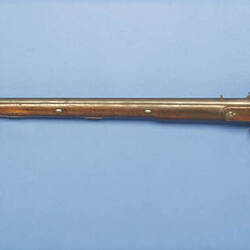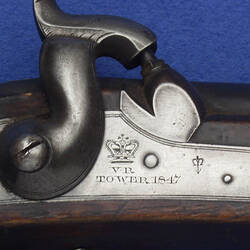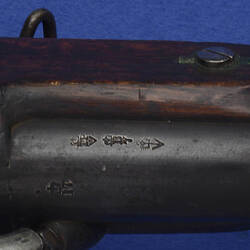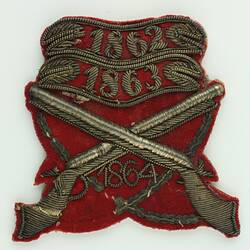Summary
British Service percussion musket, Pattern 1842 Musket, cal. .753 in., steel smoothbore round barrel, 992 mm long, with Lovell's bayonet catch on R.H.side.
Issued to the 40th Foot (2nd Somersetshire Regiment), an infantry regiment of the British Army stationed in Victoria from 1852 to 1860, used these guns in the attack on Eureka Stockade, Ballarat on 3 December 1854.
One of 26 guns donated in 1871 by the Victorian Ordnance Department from its Melbourne Armoury, for the newly created Industrial and Technological Museum. The display was intended to show mechanics and gunsmiths the principles of gun construction and recent technical developments in weapons.
Physical Description
Steel side lock and hammer on R.H. side, brass oval triggerguard with small front spur and longer rear extension, two brass 'Lovell's sidenail cups' for lockplate screws on L.H.side, brass foreend and butt plate, two sling swivels, one mounted from triggerguard, the other above front ramrod tube. Block foresight, V-notch rear sight, barrel fastened to stock via three barrel keys, steel ramrod, and three brass ramrod tubes, the front one being trumpet shaped. Lockplate stamped with a crown over 'V-R/ TOWER 1847' and a smaller crown and broad arrow combined. Stamped on stock R.H.side with government broad arrow over 'BO' and '1854' over an illegible mark. Stamped on underside and L.H.side of stock 'W SCOTT'. Ordnance marks stamped on underside of stock near triggerguard. Barrel L.H.side stamped with particularly clear Birmingham government proof marks. Barrel not removed for inspection on this date (7/9/05). Barrel top at breech stamped with a crown over '17'. Buttplate tang stamped '40/ E/ 2'.
Significance
This is a particularly important item in the Museum's collection. The Pattern 1842 musket was issued by both the 12th Foot (East Suffolk Regiment) and the 40th Foot (2nd Somersetshire Regiment) before being stationed in Australia. Companies of both these Regiments used these arms in the attack on the Eureka Stockade in December 1854. When the Regiments departed for the Maori Wars in 1863, they were re-equipped with the Pattern 1853 Enfield rifle and their Pattern 1842 muskets were subsequently relegated to the Melbourne Armoury store. This one remained there for a further eight years before being presented to the newly formed firearm collection of the Industrial and Technological Museum in 1871.
More Information
-
Collecting Areas
-
Acquisition Information
Donation (Probable) from Melbourne Armoury, 24 Oct 1871
-
User
Victoria: Ordnance Branch, Melbourne, Greater Melbourne, Victoria, Australia, 1840s-1860s
-
Inscriptions
Stamped on barrel L.H.side: crown over 'TP' over arrow (TP - Tower Proof); crown over 'B' over '7' (Birmingham proof); crown over broad arrow. Stamped on barrel top at breech: crown over 17 Stamped on butt tang: 40/ E/ 2 Stamped on lockplate: V-R/ TOWER 1847, (crown) and broad arrow Stamped on stock L.H.side: W SCOTT Stamped on stock underside: W SCOTT Stamped on stock R.H.side: broad arrow over 'BO'; '1854' over illegible mark.
-
Model Name or Number
-
Brand Names
-
Classification
-
Category
-
Discipline
-
Type of item
-
Overall Dimensions
139.8 cm (Length), 6.5 cm (Width), 21.3 cm (Height)
Barrel length: 99.20cm
-
References
[Book] Penrose, Edgar H. 1949. Descriptive Catalogue of the Collection of Firearms in the Museum of Applied Science of Victoria. 161. 14.
-
Keywords
Eureka Stockade, Ballarat, 1854, Rifles & Muskets: British, Rifles & Muskets: Military, Victorian Colonial Defence Forces







